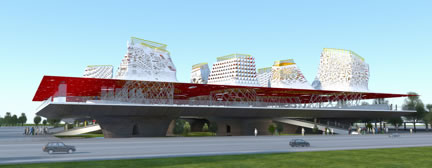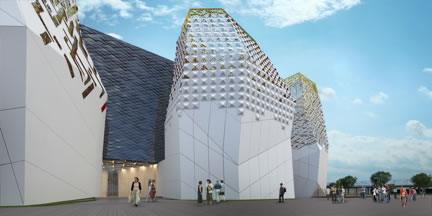BUDAPEST, November 16, 2010 – GRAPHISOFT announced today that the Russian Pavilion of the Shanghai World Expo 2010 has won second prize in the Theme Development category. The pavilion was designed using Archicad by the architects of TOTEMENT/PAPER, lead by Levon Airapetov.
The architects were challenged to propose Russia’s national pavilion that would fit the theme of the exhibition «Better City – Better Life» and also articulate the modern image of Russia. The «Buyan Grad Towns and Legends” concept by TOTEMENT/PAPER’s architects was recognized as the best work. Buyan-grad is the mythical desperado town known from Russian literature. The project was based on the idea of tripartite principle of world order, an idea that is close both to Russian and Chinese cultures. The three-level pavilion presents the idea of harmonious development in a modern city. The Park on the ground level resembles Nature, Past and Earth. The middle level’s snowy platform is a reminder of Civilization, Present and Human. The roof level with the open towers symbolizes Cities, Future and Sky, and also represents the legendary city of Buyan Grad.

The winning project of the
Russian National pavilion and World Expo 2010 competition
The architects had to design and implement the project in an extremely short period of time. Due to the effects of the economic crisis and an altered exhibition set design, the architects had to redesign the pavilion, retaining the overall concept.
One of the architects of the project, Diana Grekova, said that the creation of the model took her twelve days. She describes the process as following: “One of the big pluses of Archicad is that you can conveniently export and import the file into different rendering and other CAD software, using the built-in converter. We sent the model in DWG format to designers in China. Using this model, the Chinese colleagues assembled the supporting structure of the towers”.

The Russian Pavilion at World Expo 2010 in Shanghai
The Russian pavilion today is a group of twelve white towers with a red and gold ornamental pattern symbolizing a rich historical and cultural heritage, rapid development and the growth of a modern, multinational country. The towers encompass a cubic mass, which houses the main exposition hall of the Russian Pavilion. This is the so-called “Energy Center” of the pavilion, from where the towers “grow.” From their monolithic base they grow to become an irregularly light structure at their upper part.

«We wanted to articulate that the process of Russia’s development is not finished and continues through today,» says architect Valeria Preobrazhenskaya, co-designer of the project. «Clearly, Russia has always been a ‘work in progress’ – through the diverse and ever-changing languages, borders, religions, etc. It unites different cultures and nations, which we tried to convey using different designs decorating the towers. The pavilions exterior has a special multi-ethnic character, transmitted through the form and decoration of the building.”
«Architecture is a secret act, when the idea turns into shape. The idea expressed in a small thing should comprise everything that is needed to develop the final result. It is important to clearly feel the subject to avoid any hesitation when creating the final result». Valeria`s comment demonstrates the creation process of the Russian pavilion well. Despite the doubts surrounding the feasibility of the architect’s intention, economic and time constraints, the Russian pavilion at World Expo 2010 in Shanghai was implemented with great success, reaching over 7.5 million visitors and winning second prize from the BIE (Bureau International des Expositions) in its category for Theme Development.
The GRAPHISOFT Representative Office in Russia and the CIS thanks TOTEMENT/PAPER and NANOSOFT, the official Russian distributor for assistance in preparing the article.